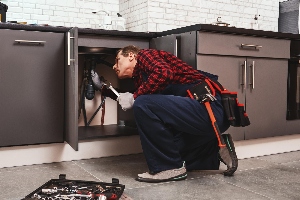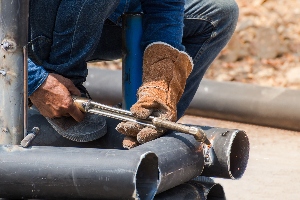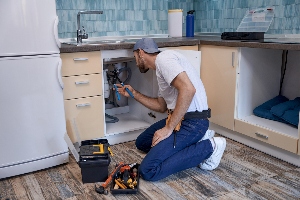As summer approaches, your yard's plumbing maintenance requires special attention to withstand the season's demands. Hot weather can strain outdoor fixtures, from garden hoses to irrigation systems, making maintenance essential for preventing costly problems.
Regular inspection and maintenance of your outdoor faucets, pipes, and drainage systems can prevent leaks and ensure efficient water use throughout the summer months. We recommend checking for dripping spigots, cracked hoses, and clogged drains early in the season before heavy use begins.
We understand that proper yard plumbing maintenance also helps conserve water during summer's peak demand periods.
Upgrading to water-efficient fixtures and addressing small problems before they escalate not only protects your property but also reduces your water bill.
This guide offers practical tips for inspecting and maintaining your yard plumbing so everything flows smoothly all summer long.
Here's what you need to know:
- Essential summer plumbing maintenance for your yard
- How to optimize outdoor water use during summer
- Enhancing plumbing and comfort systems for summer
- Seasonal plumbing maintenance tips to protect your yard
Taking these proactive steps now will keep your outdoor plumbing functioning smoothly all season long.
Essential summer plumbing maintenance for your yard
Keeping your yard plumbing in good condition during summer can prevent costly repairs and ensure everything works properly when you need it. Regular maintenance tasks now will save you headaches later.
How to inspect your outdoor plumbing for leaks
Start by checking all outdoor faucets and hose bibs for leaks. Even small drips can waste gallons of water over time and increase your water bill. Turn each faucet on and off, watching for leaks around handles and connections.
Don't forget to examine hoses for cracks, splits, or punctures. Replace damaged sections or entire hoses if necessary. Look for wet spots in your yard when sprinklers haven't run recently - this could indicate an underground pipe leak.
Check irrigation systems thoroughly. Run each zone for a few minutes while looking for unusual spray patterns, clogged heads, or water pooling. Replace broken sprinkler heads and adjust those that spray sidewalks or driveways instead of plants.
We recommend inspecting all connection points where hoses attach to faucets. Worn washers are a common cause of leaks and are inexpensive to replace.
Why gutter maintenance matters for your yard's drainage
Gutters play a crucial role in your yard's drainage system. Clogged gutters can lead to water damage on your home's foundation and create soggy areas in your yard.
Remove leaves, twigs, and debris from gutters at least twice during summer. Use a garden hose to flush remaining dirt and check for proper water flow. Ensure downspouts direct water away from your foundation, ideally 5-10 feet away.
Consider installing gutter guards if you have many trees nearby. These reduce maintenance needs while keeping water flowing properly.
Check that gutters are securely attached to your home. Repair any sagging sections or loose fasteners. Make sure the slope allows water to flow toward downspouts without pooling.
We recommend checking gutters after heavy storms when debris is most likely to accumulate.
Waterproof and caulk outdoor fixtures
Protect outdoor plumbing fixtures from summer heat and sudden rainstorms with proper waterproofing. Inspect and replace deteriorating caulk around outdoor faucets and fixtures.
According to the U.S. Environmental Protection Agency (EPA), regularly checking plumbing fixtures and connections for leaks is one of the simplest actions homeowners can take to conserve water and prevent costly damage.
Apply fresh waterproof caulk where pipes enter your home's exterior walls. This prevents water intrusion that can damage your home's structure and create mold problems.
For outdoor showers or sinks, check that drainage works properly. Clear any blockages and ensure water flows away from structures.
Consider adding faucet covers for extra protection against UV damage. These inexpensive shields extend the life of outdoor fixtures and prevent cracks from temperature fluctuations.
We recommend using silicone caulk specifically designed for outdoor use, as it withstands temperature changes better than standard varieties. Apply it on dry surfaces after thoroughly cleaning the area.
How to optimize outdoor water use during summer
Summer presents challenges for yard water management. Proper watering techniques and system maintenance can save money while keeping your landscape healthy despite the heat.
Efficient lawn watering techniques
Water your lawn early in the morning (4-10 AM) to reduce evaporation from summer heat. This timing allows water to soak into the soil before the day's heat intensifies.
Adjust your watering schedule based on weather conditions. During hot, dry periods, your lawn may need more frequent watering, while cooler or rainy days require less. This responsive approach prevents water waste and protects turfgrass health.
Consider installing a smart sprinkler system with moisture sensors. These systems automatically adjust watering based on soil conditions and weather forecasts, potentially reducing water usage by 20-30%.
To improve water absorption, aerate your lawn annually. This allows water to penetrate deeper into the soil, promoting stronger root growth and reducing runoff.
Plumbing tips for garden and irrigation system maintenance
Check irrigation systems monthly for leaks or blockages. Even small drips can waste hundreds of gallons and increase your water bills unnecessarily. Replace cracked hoses and repair leaking connections promptly.
Install drip irrigation for garden beds and planters. These systems deliver water directly to plant roots, using up to 50% less water than conventional sprinklers while promoting healthier growth.
Use mulch around plants and in garden beds to retain moisture. A 2-3 inch layer can reduce evaporation by up to 70% and helps maintain consistent soil moisture levels during intense summer heat.
Consider grouping plants with similar water needs together. This practice, called hydrozoning, prevents overwatering some plants while underwatering others, improving overall garden health and water efficiency.
Enhancing plumbing and comfort systems for summer
Your home's comfort systems work alongside your plumbing to create a pleasant living environment. Proper maintenance of these systems can save money while ensuring everything runs smoothly during the hot summer months.
Check and maintain outdoor HVAC systems
Regular HVAC maintenance is crucial for summer comfort and efficiency. We recommend cleaning or replacing air filters every 1-2 months during heavy use periods. Dirty filters make your system work harder and use more energy.
Clear debris like leaves, twigs, and grass clippings from around your outdoor AC unit. This simple step helps airflow and prevents system strain.
Have a professional inspect your HVAC system before summer's peak. They can catch small issues before they become expensive problems.
Consider upgrading to a programmable thermostat. These devices can save up to 10% on cooling costs by automatically adjusting temperatures when you're away or sleeping.
Check refrigerant levels and electrical connections during maintenance visits. Low refrigerant can damage your compressor, while loose connections pose safety hazards.
Improve home insulation and ventilation
Good insulation keeps cool air in and hot air out during summer. Check attic insulation levels—most homes need 12-15 inches for optimal efficiency.
Seal gaps around windows, doors, and pipes with weatherstripping or caulk. Even small leaks can dramatically increase energy bills.
Install ceiling fans to improve air circulation. When used with air conditioning, they can make a room feel 4°F cooler while using minimal electricity.
Consider adding window films or treatments that block solar heat. These can reduce heat gain by up to 70% in some cases.
Proper ventilation prevents moisture buildup that can damage plumbing and create mold issues. Check bathroom and kitchen exhaust fans regularly to ensure they're working correctly.
Monitor indoor air quality and safety devices
Test carbon monoxide and smoke detectors monthly. Replace batteries twice yearly and replace the entire units every 5-7 years.
Consider installing water leak detectors near washing machines, water heaters, and under sinks. These can alert you to small leaks before they cause major damage.
Clean air ducts every 3-5 years to remove dust, allergens, and potential mold. This improves air quality and system efficiency.
Use air purifiers in high-traffic areas of your home. They help remove pollutants that can trigger allergies or respiratory issues.
Check humidity levels, ideal indoor humidity is between 30-50%. Too much humidity can damage plumbing components and promote mold growth.
Seasonal plumbing maintenance tips to protect your yard
Regular maintenance of your yard and plumbing systems not only prevents costly repairs but also preserves your property's value over time. Taking proactive steps each season can make a significant difference in how well your home weathers changing conditions.
Schedule regular yard and plumbing checkups
We recommend inspecting your outdoor plumbing at least twice a year. Spring and fall are ideal times to check for issues before extreme temperatures arrive.
Look for signs of freezing damage on outdoor faucets, such as cracks or leaks. These problems often go unnoticed until they cause significant damage.
Turn off the main water supply before leaving for extended periods, especially during summer vacations. This simple step prevents unexpected leaks or pipe bursts while you're away.
Check sprinkler systems for proper function. Replace broken heads and adjust spray patterns to ensure efficient watering without waste.
For maximum protection, we suggest installing freeze-proof outdoor faucets in colder states. They cost more initially but prevent expensive repairs later.
How power washing supports outdoor plumbing maintenance
Power washing is an effective maintenance tool that extends the life of your outdoor surfaces. It removes built-up dirt, mold, and mildew that can damage materials over time.
Best surfaces for power washing:
- Concrete driveways and walkways
- Vinyl siding
- Wooden decks
- Stone patios
- Outdoor plumbing fixtures
We recommend washing these surfaces in spring as part of your seasonal maintenance routine. This removes winter grime and helps identify any damage that needs repair.
Use appropriate pressure settings for different materials. Too much pressure can damage wood and some siding types.
Consider hiring professionals for large jobs or if you're unsure about proper techniques. The investment pays off through extended lifespan of your outdoor features.
Conclusion
Summer plumbing maintenance for your yard isn’t just about avoiding leaks, it’s about protecting your home’s infrastructure, conserving water, and ensuring your outdoor systems run efficiently when you need them most.
From inspecting irrigation lines and sealing fixtures to optimizing lawn watering and maintaining your HVAC system, these proactive steps save money and prevent bigger issues down the line.
With a few seasonal checkups and basic repairs, you can keep your outdoor plumbing in excellent shape all summer long.
For complex issues or buried line inspections, don't hesitate to call us!












